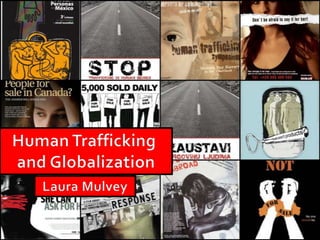
Human Trafficking And Globalization
- 2. “Trade in people and their parts that involves the use of improper means- e.g. force, fraud, deception, coerci on, or the abuse of power or authority- to recruit or transport them within or across borders for the purposes of exploitation.” - UN Office on Drugs and Crime, 2008
- 3. Smuggling- unauthorized border crossings Trafficking is a crime against a person, while smuggling is the facilitated illegal entry from one country to another There is no coercion or forced labor involved in smuggling In the eyes of the law, a trafficked person is seen as a victim, while a smuggled person is seen as a criminal
- 4. Many types of people are trafficked Age, gender, level of education Many marginalized groups are at risk (ethnicity, nationality, class background) Gender differences depending on type of work Migrants are vulnerable, due to tight immigration laws and lack of knowledge about migration laws Orphaned children especially vulnerable (from HIV or in areas of conflict)
- 5. Economic Social Personal Civil unrest Political prosecution Gender based discrimination
- 6. 1) Process 2) Means 3) End
- 7. Process- Recruiting, harboring, moving, obtaining a person Traffickers include: ▪ Recruiters ▪ Recruitment agencies ▪ Transporters ▪ Middlemen- who ‘buy’ and ‘sell’ ▪ Debt collectors ▪ Employers
- 8. Methods: Through acquaintance/family Newspaper adds Fake employment agencies Front businesses Abduction
- 9. Means – force, fraud, coercion Low-risk enterprise for traffickers Organized crime, mafia etc. Informal networks Small-scale or shot-term Family based or freelance operations
- 10. Methods: Threats of deportation Holding passports Threats to family members Isolation Verbal, physical and sexual abuse Giving drugs Providing misinformation
- 11. End – involentary servitude, debt bondage, slavery, sex trade Adults (varies)- Particularly Women- Sweatshops Domestic service Factory work Marriages Agriculture Sex trade Organ harvesting Hotel/motel housekeeping Begging/peddling Restaurant work
- 12. Children- Sex trade Begging Work in mines Early marriages Soldiers Fishing Crime Jockeys
- 13. Lack of data Difficult to obtain data on trafficked persons Majority seems to be women and children Estimates of numbers vary Range from 500,00 to 4 million people trafficked per year
- 14. Both Domestic and international Generally from poor areas of developing countries into comparatively wealthier ones Several Regions- flow of trafficking: ▪ Europe and Eurasia ▪ Asia ▪ Latin America and US ▪ Middle East ▪ Africa *Traffic also among regions
- 15. destination area source area To Middle East
- 16. To US destination area source area To Middle East Africa
- 19. Criminal Political Anthropological Sociological Economic Legal Feminist
- 20. Although human trafficking is not a new problem, the dynamics of globalization are fueling its growth Though growing trade and effortless world travel Humans as commodities, as part of quot;hyper- capitalismquot; Incorporation into global market supply and demand Global trade networks As migration and transnationalism Looking at a variety of motivating factors Transnational networks
- 21. Influences the economic “push” and “pull” Changing lures of immigration Tight immigration laws: promote alternate migration practices Trafficking becoming part of the global economy Transnational network Exploit uneven development
- 22. Combination of political corruption and organized crime promotes significant growth on global scale Political instability/corruption -> vulnerability Traffickers take advantage of transparent borders, broadband communication Political/economic upheaval Mass migrations
- 23. The global effort to combat human trafficking is organized around prevention, prosecution, and protection Economic development, with a special emphasis on women and girls, constitutes perhaps the best long- term approach to combating human trafficking. Prosecution of traffickers also has a strong prevention aspect. Breaking up trafficking networks and imprisoning traffickers stops the recruitment and movement of trafficked persons. Between 2001 and 2005, the United States successfully convicted only 138 human traffickers (US DOJ, 2006
- 24. A Slow War on Human Trafficking Julia Mead, NY Times, May 2006 Globalization and Human Trafficking Loring Jones, Journal of Sociology and Social Welfare, v. 34, 2007 Human Trafficking: Globalization, Exploitation, and Transnational Sociology, Stephanie A. Limoncelli, Sociology Compass, v. 3, Dec 2008
